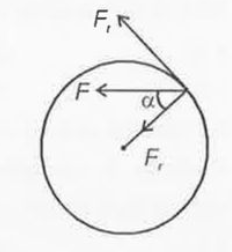a particle is moving in a circle of radius R in such a way that at any instant the normal and the tangential component of its acceleration are equal. If its speed at t=0 is v0 then time it takes to complete the first revolution is Rαv0(1−e−βπ). Find the value of (α+β).
The correct Answer is:3
To solve the problem, we need to analyze the motion of a particle moving in a circle with a radius R where the normal (centripetal) and tangential components of acceleration are equal. Let's break down the solution step by step.
Step 1: Understanding the Acceleration Components
The normal component of acceleration an is given by:
an=v2R
where v is the speed of the particle.
The tangential component of acceleration at is given by:
at=dvdt
According to the problem, these two components are equal:
v2R=dvdt
Step 2: Rearranging the Equation
We can rearrange the equation to separate variables:
dvv2=dtR
Step 3: Integrating Both Sides
Now, we integrate both sides. The left side integrates from v0 to v and the right side from 0 to t:
∫vv0dvv2=∫t0dtR
The integral of 1v2 is −1v, so we have:
−1v+1v0=tR
Rearranging gives:
t=R(1v0−1v)
Step 4: Finding the Final Velocity After One Revolution
Next, we analyze the motion over one complete revolution. The distance traveled in one revolution is 2πR. The tangential acceleration is also equal to the normal acceleration, which gives us:
at=dvdt=v2R
Using the relationship ds=vdt, we can express the tangential acceleration as:
at=vdvds
Setting these equal gives:
v2R=vdvds
This simplifies to:
dvv=dsR
Step 5: Integrating for One Revolution
Integrating from 0 to 2πR gives:
∫vv0dvv=∫2πR0dsR
This results in:
ln(vv0)=2πRR=2π
Exponentiating both sides gives:
vv0=e2π⟹v=v0e2π
Step 6: Substituting Back to Find Time
Substituting v back into the time equation:
t=R(1v0−1v0e2π)=R(1v0−e−2πv0)
This simplifies to:
t=Rv0(1−e−2π)
Step 7: Comparing with Given Expression
The problem states that the time taken to complete the first revolution is given by:
t=Rαv0(1−e−βπ)
Comparing both expressions, we find:
α=1andβ=2
Final Step: Calculate α+β
Thus, we find:
α+β=1+2=3
Conclusion
The final answer is:
3
The normal component of acceleration an is given by:
an=v2R
where v is the speed of the particle.
at=dvdt
According to the problem, these two components are equal:
v2R=dvdt
We can rearrange the equation to separate variables:
dvv2=dtR
Now, we integrate both sides. The left side integrates from v0 to v and the right side from 0 to t:
∫vv0dvv2=∫t0dtR
The integral of 1v2 is −1v, so we have:
−1v+1v0=tR
Rearranging gives:
t=R(1v0−1v)
Next, we analyze the motion over one complete revolution. The distance traveled in one revolution is 2πR. The tangential acceleration is also equal to the normal acceleration, which gives us:
at=dvdt=v2R
Using the relationship ds=vdt, we can express the tangential acceleration as:
at=vdvds
Setting these equal gives:
v2R=vdvds
This simplifies to:
dvv=dsR
Integrating from 0 to 2πR gives:
∫vv0dvv=∫2πR0dsR
This results in:
ln(vv0)=2πRR=2π
Exponentiating both sides gives:
vv0=e2π⟹v=v0e2π
Substituting v back into the time equation:
t=R(1v0−1v0e2π)=R(1v0−e−2πv0)
This simplifies to:
t=Rv0(1−e−2π)
The problem states that the time taken to complete the first revolution is given by:
t=Rαv0(1−e−βπ)
Comparing both expressions, we find:
α=1andβ=2
Thus, we find:
α+β=1+2=3
The final answer is:
3
Topper's Solved these Questions
- BOOK - ALLENCHAPTER - KINEMATICSEXERCISE - EXERCISE-0155videos
KINEMATICS
- BOOK - ALLENCHAPTER - KINEMATICSEXERCISE - EXERCISE-0257videos
KINEMATICS
- BOOK - ALLENCHAPTER - ERROR AND MEASUREMENTEXERCISE - Part-2(Exercise-2)(B)22videos
ERROR AND MEASUREMENT
- BOOK - ALLENCHAPTER - KINEMATICS (MOTION ALONG A STRAIGHT LINE AND MOTION IN A PLANE)EXERCISE - BEGINNER S BOX-78videos
KINEMATICS (MOTION ALONG A STRAIGHT LINE AND MOTION IN A PLANE)
Similar Questions
A particle is moving in a circle of radius R in such a way that at any instant the normal and tangential component of the acceleration are equal. If its speed at t=0 is u0 the time taken to complete the first revolution is
View SolutionA particle is moving on a circle of radius R such that at every instant the tangential and radial accelerations are equal in magnitude. If the velocity of the particle be v0 at t=0, the time for the completion of the half of the first revolution will be
View SolutionA particle is moving along a circular path ofradius R in such a way that at any instant magnitude of radial acceleration & tangential acceleration are equal. 1f at t = 0 velocity of particle is V0. Find the speed of the particle after time t=(R)/(2V0)
View SolutionA particle is moving on a circle of radius A .At an instant its speed and tangential acceleration are B and C respectively.Total acceleration of the particle at that instant is
View SolutionA particle is moving with speed v in a circle of radius R. Find the magnitude for average velocity of point
for the half revolutionView SolutionThe speed of a particle moving in a circle of radius r=2m varies with time t as v=t2, where t is in second and v in m/s. Find the radial, tangential and net acceleration at t=2s.
View SolutionA particle moves in a circle of radius 30cm. Its linear speed is given by v=2t, where t in second and v in m/s. Find out its radial and tangential acceleration at t=3s.
View SolutionA particle of mass m is moving in a circle of radius (r) with changing speed (v) the direction of centripetal force and tangential force are shown below the value of α is
 View Solution
View SolutionThe speed of a particle moving in a circle of radius r=2m varies with time t as v=t2, where t is in second and v in m/s. Find the radial, tangential and net acceleration at t=2s.
View SolutionA Particle of mass 'M' moves in a uniform circular path of radius 'r' with a constant speed 'v' then its centripetal acceleration is .
View Solution

